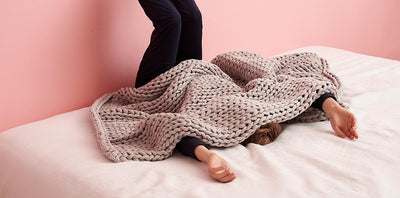How To Sleep After Knee Replacement, Best Positions And More
For better sleep after knee replacement, try lying on your back with a small pillow under the upper-calf muscle. The goal is to keep your leg relatively straight to allow for proper blood flow and prevent any hyperextension. If you prefer side sleeping, place a pillow between the knees for support

Bearassentials
The best sleeping position when recovering from knee surgery is on your back with your leg supported by a pillow.
If you prefer side sleeping, prop up the recovering knee with a body pillow between the legs.
Avoid putting the leg in a position where the knee is bent or hyperextended.
Did you know?
Total knee arthroplasty is a surgery commonly performed to treat osteoarthritis. Since it helps relieve pain in the knee, patients typically see improved sleep as a result.
Have you recently undergone knee surgery? Having trouble getting comfortable enough in bed for proper sleep?
Figuring out how to sleep after knee replacement can be the hardest part of recovery. But while some discomfort is to be expected, you don’t need to give up on the dream of quality shut-eye.
Learning the best sleeping positions and the proper way to set yourself up in bed can go a long way to enhancing your rest.
The Effects Of Knee Surgery On Sleep
After going under the knife, you’re sure to notice some changes to your quality of life. Sleep is no different.
In a previous article we explored how pain affects sleep, highlighting how chronic pain interrupts sleep cycles and keeps you up. Pain experienced while recovering from knee replacement is no different.
A 2021 study published in The Journal of ISAKOS took 123 arthroscopic knee surgery patients and gauged the number of sleep disturbances before and after surgery. Prior to surgery there was a 20% chance of self-reported sleep disturbance. After surgery, that number shot up to 99%, 96%, and 90% at weeks 1, 3, and 6, respectively.
The good news is that other studies have shown sleep continues to improve over time and eventually beats out pre-operation levels.
The takeaway? Difficulty sleeping in the beginning is normal, but there are ways to make it a little easier on yourself while aiding recovery.
The Best Position To Sleep In After Knee Replacement
This may come as a shock to side sleepers, but the best position to sleep in after knee replacement is on your back. More specifically, on your back with a bit of pillow support
The reason it’s the king of post-knee surgery sleeping positions has to do with the placement of the knee. Lying on your back allows the leg to remain fairly straight and immobile, increasing blood flow to the healing knee and preventing strain. Think of that added juice to the knee as the fuel that gets you back on your feet.
While side sleeping isn’t impossible it can put the knee in awkward positions throughout the night, leading to painful sleep disturbances. That said, it’s the most popular sleeping position, so it may be difficult for some people to avoid.
And if you get set up properly, it’s definitely not the worst way to sleep after surgery.
Top 5 Mistakes After Knee Replacement
There are ways that any sleeping position can go wrong, and there are positions that are flat-out bad for your knee after surgery. On top of that, there are a few other mistakes to avoid for optimal recovery.
Mistake Number 1: Sleeping With The Knee Bent
Whether you end up on your back or your side, preventing your knee from bending too much is crucial. What’s too much? Consider a 45 degree angle the most you’ll want to bend your knee. However, the number one rule is to avoid pain, so if it starts to feel uncomfortable, that’s your body’s way of telling you to back it up.
Mistake Number 2: Sleeping With The Knee Hyperextended
While sleeping on your back is the best position to sleep in after knee replacement, gravity can sometimes push the knee down too far, causing it to bend slightly in the wrong direction. Look out for old beds with uneven surfaces and pillows placed too far toward the foot.
Mistake Number 3: Sleeping On The Stomach
If there’s one sleep position to avoid, it’s lying belly-down. Being on your stomach makes it hard to keep your knees in the right position, and it also naturally leads to a lot of bending, flexing, and movement. If it’s your go-to sleep position, you may want to set it aside until after you’ve fully recovered.
Mistake Number 4: Ignoring Pillows
Whether you’re recovering from shoulder surgery or you’re trying to get better sleep after partial knee replacement, you won’t want to ignore pillows. Post-operation recovery is one of the many benefits of body pillows when positioned properly. More on that below.
Mistake Number 5: Not Managing Pain Properly
If you’re managing postoperative pain, bedtime prep starts long before you slip under the sheets. For example, consider taking your pain meds 30 minutes to an hour before bed. Icing the knee before bed can also help limit any pain through the night.

How To Use A Body Pillow After Knee Replacement
Enough about mistakes to avoid. It’s time for pillow tips that can help relieve pain
Studies have shown that body pillows are effective at boosting spinal surgery recovery, and they may work similarly for knee surgery, too. Just try to place the pillow properly so that the knee can stay in a stable position throughout the night.
Body Pillow Positioning For Back Sleepers
Back sleeping is great on its own for some, but to take it to the next level and provide the most comfort possible, you might want to try placing our body pillow under the calf muscle just below the knee. The adaptable Melofoam™ can help keep your knee secure with minimal interruptions to sleep. As an added bonus, propping the knees up slightly can also help with spine alignment.
Body Pillow Positioning For Side Sleepers
A body pillow is even more essential if you want to sleep on your side after knee replacement. For best results, place it between your knees with the recovering knee on top. As an added bonus, you can take advantage of the Cuddler’s size by wrapping your arms around it. This may help keep your entire body in a steady position.
Can I Have My Leg Raised During Sleep After Knee Replacement?
Anyone with first-aid knowledge will know that keeping injured body parts elevated is helpful after an injury. It helps to keep swelling down and relieve pain at the site of the injury.
Likewise, you can have your leg raised during sleep after knee replacement if it feels good to you. Just make sure you’re propping the leg up with pillows from the top of the calf muscle down and avoid bending or hyperextending the knee too much.
Make sure you set your pillows up in a way that’s comfortable so that they’re not putting pressure on the wrong areas. This can lead to nerves being compressed, leaving your leg with pins and needles.
Play around with a few positions and see what feels right to you.
Conclusion
Sleeping after knee replacement poses a painful challenge, especially in the first months of recovery. For best results, try to sleep on your back with our Cuddler supporting the underside of the knee. Sleeping on your side with a body pillow between your knees may also help as long as you keep the knee relatively straight.
Remember, if you’re in pain now, you probably won’t be forever. There’s light at the end of the surgery recovery tunnel, and a better sleep position can help get you there.






